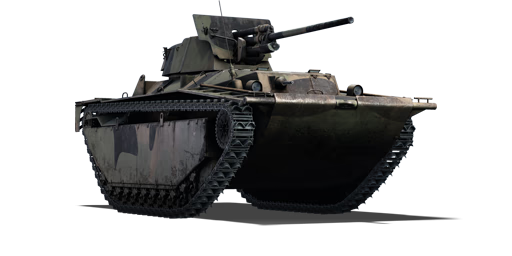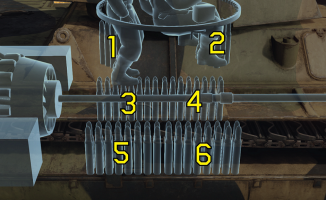Difference between revisions of "LVT(A)(4) (ZIS-2) (USA)"
(→Main armament) |
|||
| Line 42: | Line 42: | ||
<!--''Give the reader information about the characteristics of the main gun. Assess its effectiveness in a battle based on the reloading speed, ballistics and the power of shells. Do not forget about the flexibility of the fire, that is how quickly the cannon can be aimed at the target, open fire on it and aim at another enemy. Add a link to the main article on the gun: <code><nowiki>{{main|Name of the weapon}}</nowiki></code>. Describe in general terms the ammunition available for the main gun. Give advice on how to use them and how to fill the ammunition storage.''--> | <!--''Give the reader information about the characteristics of the main gun. Assess its effectiveness in a battle based on the reloading speed, ballistics and the power of shells. Do not forget about the flexibility of the fire, that is how quickly the cannon can be aimed at the target, open fire on it and aim at another enemy. Add a link to the main article on the gun: <code><nowiki>{{main|Name of the weapon}}</nowiki></code>. Describe in general terms the ammunition available for the main gun. Give advice on how to use them and how to fill the ammunition storage.''--> | ||
| + | [[File:Ammoracks_LVT(A)(4)ZIS-2.png|right|thumbnail|x200px|Ammo Racks|Ammo racksof the LVT(A)(4) ZIS-2.]] | ||
| + | === Ammo Racks === | ||
| − | |||
| − | |||
{| class="wikitable sortable" style="text-align:center" | {| class="wikitable sortable" style="text-align:center" | ||
| Line 79: | Line 79: | ||
=== Machine guns === | === Machine guns === | ||
[[M1919A4 (7.62 mm)]] | [[M1919A4 (7.62 mm)]] | ||
| + | |||
== Usage in the battles == | == Usage in the battles == | ||
Revision as of 21:52, 22 April 2020
Contents
Description
The ▃LVT(A)(4) (ZIS-2) is a gift rank II American SPG with a battle rating of 2.3 (AB/RB/SB). It was introduced the winter holiday event of 2016.
Being based off the LVT(A)(1) with the difference of a new turret that hosts a soviet zis gun, offering much more firepower compared to its counterpart.
General info
Survivability and armour
Armour type:
- Rolled homogeneous armour
- Cast homogeneous armour (Gun mantlet, Machine gun shield)
| Armour | Front (Slope angle°) | Sides | Rear | Roof |
|---|---|---|---|---|
| Hull | 12.7 mm (31°) Front plate 6.35 mm (83-84°) Upper glacis 6.35 mm (41-81°) Lower glacis |
6.35 mm (11-51°) Top 6.35 + 6.35 mm Bottom |
6.35 mm (0-62°) | 6.35 mm |
| Turret | 38 mm (10°) Turret front 5 mm (1-81°) Gun mantlet |
25 mm | 25 mm | N/A |
Notes:
- Suspension wheels and tracks are 15 mm thick.
- Front hull has flat armour area where driver & co-driver sits.
Mobility
| Game Mode | Max Speed (km/h) | Weight (tons) | Engine power (horsepower) | Power-to-weight ratio (hp/ton) | |||
|---|---|---|---|---|---|---|---|
| Forward | Reverse | Stock | Upgraded | Stock | Upgraded | ||
| Arcade | 44 | 6 | 18.3 | 355 | 477 | 19.4 | 26.07 |
| Realistic | 40 | 5 | 221 | 250 | 12.08 | 13.66 | |
Armaments
Main armament
Ammo Racks
| Full ammo |
1st rack empty |
2nd rack empty |
3rd rack empty |
4th rack empty |
5th rack empty |
6th rack empty |
Visual discrepancy |
|---|---|---|---|---|---|---|---|
|
76 |
71 (+5) |
65 (+11) |
49 (+27) |
33 (+43) |
17 (+59) |
1 (+75) |
Machine guns
Usage in the battles
LVT(A)(4) Zis-2 is a fragile tank with a strong bite. The main gun is a very powerful Soviet Zis-2 that have no problem penetrating through the hardest of enemies at its BR. Being such a large tank it got an amazing manouverbility that works on most terrain. It's high profile makes it a easy target for enemy to spot from afar and behind objects, fences and hills. Since the LVT(A)(4) got such thin hull armor makes it vulnerable to machine gun and auto cannon fire. This makes Self Propelled Anti-Air vehicles and vehicles with a 20mm Automatic cannons a lethal enemy, but that is not all the worries, large caliber guns with HEAT and HE can with ease penetrate and cause detonation to the soft armor of the LVT(A)(4).
LVT(A)(4) Zis-2 got a decent speed and maneuverable to handle close combat with even with a lacking of a full 360° turret. But to best counter the most dangerous of enemies is to utilize the long gun to its advantage.
Pros and cons
Pros:
- Good speed and maneuverability
- Five crew members
- Powerful main gun
- Decent elevation and depression
- Well-armed turret can lead to some shells bouncing
- Amphibious
- Spaced Interior
Cons:
- High Profile
- Very thin hull, penetration by any main armament and machine guns
- The crew in the turret are very close together, meaning they'll be taken out in a single shot
- Open Top
- Limited turret traverse
History
The LVT series of tracked amphibious vehicles originated from a pre-war civilian design, the Alligator hurricane rescue vehicle which had been designed by Donald Roebling (1908-1959) in 1935. An article on a further development of this vehicle in 1937 caught the attention of the US Marine Corps, but initially the proposal of militarising the Alligator met resistance both from the US Navy, who felt conventional landing craft could do the job just as well, and from Roebling himself, who disliked the idea of his vehicle being used for military purposes. The outbreak of war in Europe persuaded Roebling into building it anyway, and by May of 1940 he had completed a militarised prototype, which was tested in November 1940 and subsequently approved for production.
Even before the first prototype had been tested, Roebling had started designing a turret-equipped armed version of his LVT, intended for providing fire support for landings. Originally the design languished, but in June of 1941 the USMC recommended the development of a fire support version of the LVT. Development of this variant was slow, as the entire LVT had to be redesigned: light armour was added to the hull and a 37 mm armed turret similar to that of the M3 Stuart light tank was mounted on top, resulting in the initial fire support variant, the LVT(A)(1).
Combat experience with the LVT(A)(1) soon showed that the 37 mm gun was insufficient for fire support purposes, so the original M3 Stuart turret was replaced by that of a 75 mm Howitzer Motor Carriage M8, creating the LVT(A)(4) variant, of which 1890 were built. Of these, several dozen were delivered to Nationalist China under the Lend-Lease Agreement.
In KMT service, the LVT(A)(4) ended up being used both against the Japanese forces during World War II, as well as against the PLA during the ensuing civil war. Most of them eventually fell into PLA hands. The lack of western supplies meant that ammo soon became sparse for the 75 mm M3 Howitzer gun mounted by the LVT(A)(4); to keep them useful as well as to bolster the number of available armoured vehicles in the PLA inventory, the LVT(A)(4)s were locally converted to either accept the 37 mm M6 tank gun - essentially retrofitting them to LVT(A)(1) status - or the 57 mm ZiS-2 anti-tank gun - identical to the gun used on the ZiS-30 tank destroyer, and technically similar to the ZiS-4 gun used on both the T-34-57 and the SU-57B.
The haphazard way in which these conversions took place, as well as the lack of official documents on them, make it unclear how many LVT(A)(4)s were converted. The lack of available spares for their automotive components makes it unlikely that they were used for long, and it is likely they were withdrawn from frontline use as soon as Soviet deliveries of tanks and armoured vehicles started in the early 1950s.
Media
An excellent addition to the article will be video guides, as well as screenshots from the game and photos.
Read also
Links to the articles on the War Thunder Wiki that you think will be useful for the reader, for example,
- reference to the series of the vehicles;
- links to approximate analogues of other nations and research trees.
ETC.
Sources
Paste links to sources and external resources, such as:
- topic on the official game forum;
- other literature.
| USA tank destroyers | |
|---|---|
| M10 | M10 GMC |
| M36 | M36 GMC · M36B2 |
| T95 | T28 · T95 |
| M109 | M109A1 |
| ATGM | LOSAT · M901 |
| Wheeled | M3 GMC · T55E1 |
| Other | M8 HMC · M50 · M56 |
| China | ▃LVT(A)(4) (ZIS-2) |





